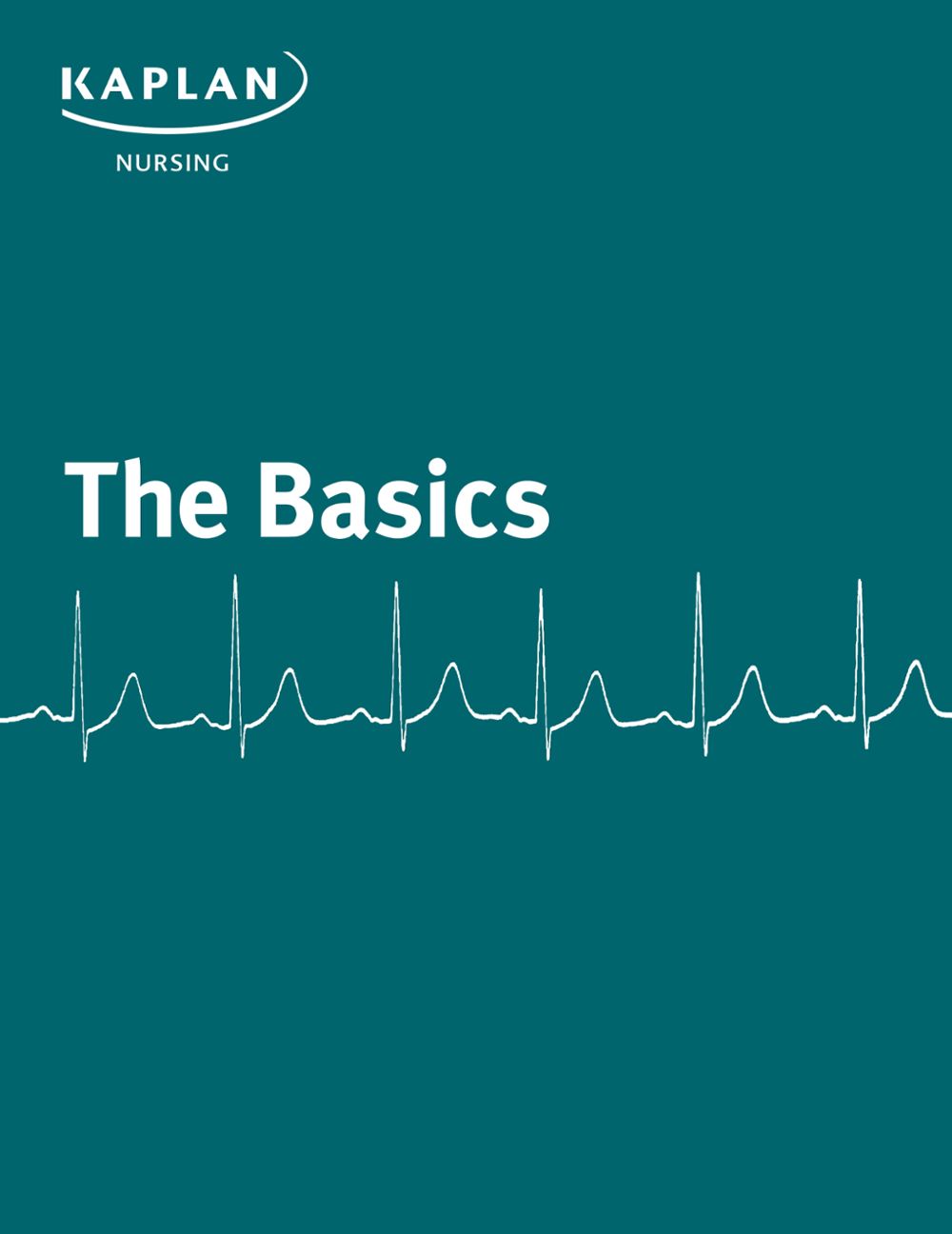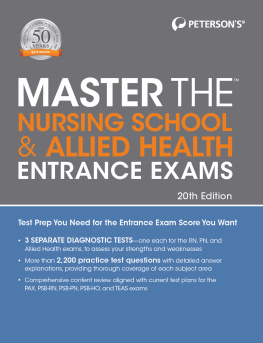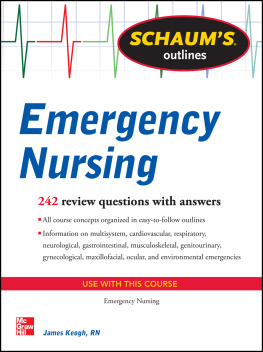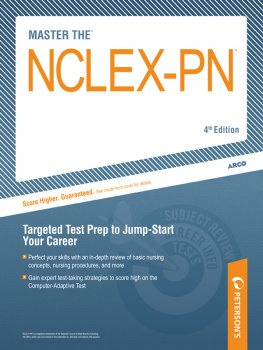
The Basics
A COMPREHENSIVE OUTLINE OF NURSING SCHOOL CONTENT
Judith A. Burckhardt, Ph.D., R.N.
Joanne Brown, M.S.N., M.P.H., R.N.
Barbara J. Irwin, M.S.N., R.N.
Marlene Redemske, M.S.N., M.A., R.N.
Contributing Editors
Judy Hyland, M.S.N., R.N.
Executive Director of Nursing
Pamela Gardner, M.S.N., R.N.
Nursing Curriculum Developer
This book is solely intended for use as preparation for the NCLEX examination. It is not a guide to the clinical treatment of clients. Neither the authors nor the publisher shall be responsible for any harm caused by the use of this book other than for its intended purpose. This book is just a small portion of the Kaplan materials available for you to prepare for the NCLEX examination.
This publication is designed to provide accurate information in regard to the subject matter covered as of its publication date, with the understanding that knowledge and best practice constantly evolve. The publisher is not engaged in rendering medical, legal, accounting, or other professional service. If medical or legal advice or other expert assistance is required, the services of a competent professional should be sought. This publication is not intended for use in clinical practice or the delivery of medical care. To the fullest extent of the law, neither the Publisher nor the Editors assume any liability for any injury and/or damage to persons or property arising out of or related to any use of the material contained in this book.
2017 by Kaplan, Inc.
Published by Kaplan Publishing, a division of Kaplan, Inc.
750, Third Avenue
New York, NY 10017
Publishing print books are available at special quantity discounts to use for sales promotions, employee premiums, or educational purposes. For more information or to purchase books, please call the Simon & Schuster special sales department at 866-506-1949.
ISBN: 978-1-5062-1465-8
All rights reserved under International and Pan-American Copyright Conventions. By payment of the required fees, you have been granted the non-exclusive, non-transferable right to access and read the text of this eBook on screen. No part of this text may be reproduced, transmitted, downloaded, decompiled, reverse engineered, or stored in or introduced into any information storage and retrieval system, in any form or by any means, whether electronic or mechanical, now known or hereinafter invented, without the express written permission of the publisher.
Chapter I
Health Assessment
Health History
DEMOGRAPHIC DATA
- Date
- Biographical information
- Client as reliable historian
- Age, sex, marital status
- Reason for seeking health care
- History of present illness/condition
PAST HEALTH HISTORY
- Past health history
- Medical history
- Surgical history
- Medications
- Communicable diseases
- Allergies
- Injuries/accidents
- Disabilities/handicaps
- Blood transfusions
- Childhood illnesses
- Immunizations
- Family health history
- Genogram
- Familial/genetic diseases
- Social history
- Alcohol/tobacco/drug use
- Travel history
- Work environment
- Home environment
- Hobbies/leisure activities
- Stressors
- Education
- Economic status
- Military service
- Religion
- Culture
- Roles/relationships
- Sexual history
- Patterns of daily living
- Health maintenance
- Sleep
- Diet
- Exercise
- Stress management
- Safety practices
- Patterns of health care practices
- Review of systems
Physical Assessment
PURPOSE
- Assess clients current health status
- Interpret physical data
- Decide on interventions based on data obtained
PREPARATION
- Gather equipment
- Ophthalmoscope
- Tuning fork
- Cotton swabs
- Snellen eye chart
- Thermometer
- Penlight
- Tongue depressor
- Ruler/tape measure
- Safety pin
- Balance scale
- Gloves
- Nasal speculum
- Vaginal speculum
- Provide for privacy (drape) in quiet, well-lit environment
- Explain procedure to client
- Ask client to empty bladder
- Drape client for privacy
- Compare findings on one side of body with other side and compare with normal
- Make use of teaching opportunities (dental care, eye exams, self-exams of breasts or testicles)
- Use piece of equipment for entire assessment, then return to equipment tray
TECHNIQUES USED IN ORDER PERFORMED, EXCEPT FOR ABDOMINAL ASSESSMENT
- General assessment
- Inspection
- Palpation
- Percussion
- Auscultation
- Abdominal assessment
- Inspection
- Auscultation
- Percussion
- Palpation
- Inspection (visually examined)
- Start with first interaction
- Provide good lighting
- Determine
- Size
- Shape
- Color
- Texture
- Symmetry
- Position
- Palpation (touch)
- Warm hands
- Approach slowly and proceed systematically
- Use fingertips for fine touch (pulses, nodes)
- Use dorsum of fingers for temperature
- Use palm or ulnar edge of hand for vibration
- Start with light palpation, then do deep palpation
- Use bimanual palpation (both hands) for deep palpation and to assess movable structure (kidney). Place sensing hand lightly on skin surface, place active hand over sensing hand and apply pressure
- Ballottementpush fluid-filled tissue toward palpating hand so object floats against fingertips
- Determine
- Masses
- Pulsation
- Organ size
- Tenderness or pain
- Swelling
- Tissue fullness and elasticity
- Vibration
- Crepitus
- Temperature
- Texture
- Moisture
- Percussion (tap to produce sound and vibration)
- Types
- Directstrike body surface with 1 or 2 fingers
- Indirectstrike finger or hand placed over body surface
- Bluntuse reflex hammer to check deep tendon reflexes; use blunt percussion with fist to assess costovertebral angle (CVA) tenderness
- Sounds (produced by direct or indirect percussion)
- Resonancemoderate to loud, low-pitched (clear, hollow) sound of moderate duration; found with air-filled tissue (normal lung)
- Hyperresonanceloud, booming, low-pitched sound of longer duration found with over-inflated air-filled tissue (pulmonary emphysema); normal in child due to thin chest wall
- Tympanyloud, drum-like, high-pitched or musical sound of moderately long duration found with enclosed, air-filled structures (bowel)
- Dullsoft, muffled, moderate to high-pitched sound of short duration; found with dense, fluid-filled tissue (liver)
- Flatvery soft, high-pitched sound of short duration; found with very dense tissue (bone, muscle)
Next page









